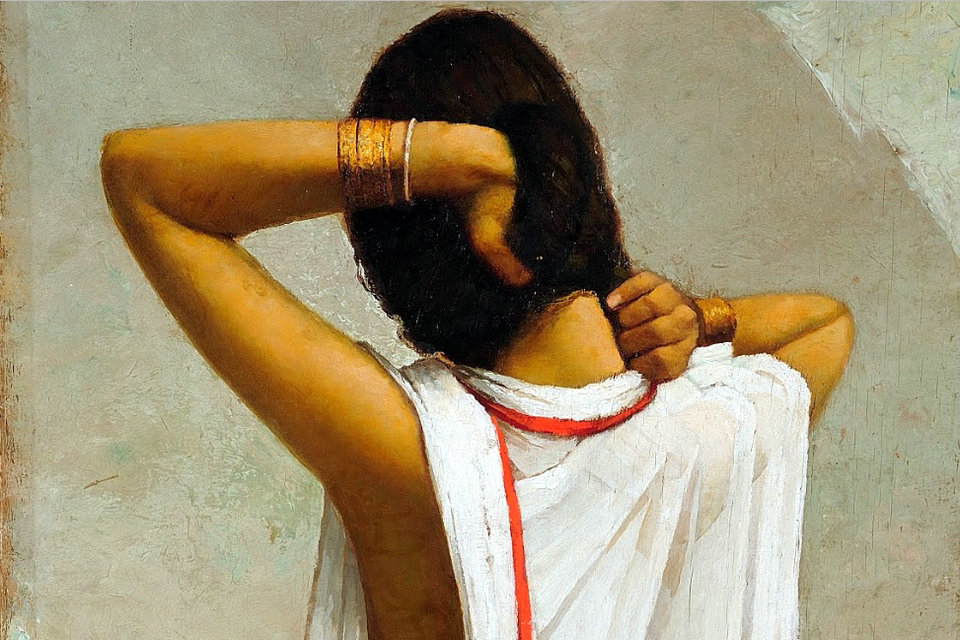India Modern Paintings, Salar Jung Museum


The Modern Indian art movement in Indian painting is considered to have begun in Calcutta in the late nineteenth century.The old traditions of painting had more or less died out in Bengal and new schools of art were started by the British. Initially, protagonists of Indian art such as Raja Ravi Varma drew on Western traditions and techniques including oil paint and easel painting. A reaction to the Western influence led to a revival in primitivism, called as the Bengal school of art, which drew from the rich cultural heritage of India. It was succeeded by the Santiniketan school, led by Rabindranath Tagore’s harking back to idyllic rural folk and rural life.
The works of about eighty five artists found representation in the museum’s collection. The departure from the tradition of classical art in India started with the emergence of Raja Ravi Varma (1848-1906), a prominent painter from South India. Raja Ravi Varma was trained in the Western traditions and painted a great deal in oil medium, depicting themes from Indian mythology and classics incorporating Indian subjects. Only two paintings viz., The Kerala Beauty and Stolen Interview by Ravi Varma adorn the gallery. The exponents of the Bengal School represented in the collection are RabindranathTagore, Nandalal Bose,Chughtai and V.S. Maroji. Have you not heard his silent steps and Musician, the two works of Abanindranath Tagore are found in the collection of the museum. Nandalal Bose, one of the pioneers of modern renaissance of Indian paintings represents a more classic phase of the Bengal school. He is represented by his two important works namely Vasant and Villagers around fire. Among the note-worthy experts who evolved a Neo-idiom in art, the museum has in its proud possession the works of artists like M.F.Hussain, K.K. Hebbar, N.S.Bendu, Panikar, K.S.Kulkarni, P.T.Reddy, Paidi Raju and Dinakar Koushik.
Salar Jung Museum:
The Salar Jung Museum is an art museum located at Darushifa, on the southern bank of the Musi River in the city of Hyderabad, Telangana, India. It is one of the three National Museums of India. It has a collection of sculptures, paintings, carvings, textiles, manuscripts, ceramics, metallic artefacts, carpets, clocks, and furniture from Japan, China, Burma, Nepal, India, Persia, Egypt, Europe, and North America. The museum’s collection was sourced from the property of the Salar Jung family. It is one of the largest museums in the world.
The Salar Jung Museum of Hyderabad is a repository of the artistic achievements of diverse European, Asian and Far Eastern countries of the world. The major portion of this collection was acquired by Nawab Mir Yousuf Ali Khan popularly known as Salar Jung III. The zeal for acquiring art objects continued as a family tradition for three generations of Salar Jungs. In 1914, Salar Jung III, after having relinquished the post of Prime Minister to H.E.H., the Nizam VII, Nawab Mir Osman Ali Khan, devoted rest of his entire life in collecting and enriching the treasures of art and literature till he lived. The precious and rare art objects collected by him for a period of over forty years, find place in the portals of the Salar Jung Museum, as rare to very rare pieces of art.
After the demise of Salar Jung-III, the vast collection of precious art objects and his Library which were housed in “Dewan-Deodi” the ancestral palace of the Salar Jungs, the desirability of organizing a Museum out of the Nawab’s collection dawned quite soon and Sri M.K. Velodi, the then Chief Civil Administrator of the Hyderabad State approached Dr.James Cousins a well known art critic, to organize the various objects of art and curios which were lying scattered in different palaces of Salar Jung III to form a Museum.
With a view to perpetuate the name of Salar Jung as a world renowned art connoisseur, the Salar Jung Museum was brought in to existence and was opened to the public by Pandit Jawaharlal Nehru, the then Prime Minister of India on 16th December, 1951.
However, the administration of the Museum continued to be vested in the Salar Jung Estate Committee till 1958. Thereafter, the heirs of Salar Jung Bahadur graciously agreed to donate the entire collection to the Government of India through a Compromise Deed based on a High Court Decree on 26th December l958. The Museum continued to be administered directly by the Government of India till 1961. Through an Act of Parliament (Act of 26 of 1961) the Salar Jung Museum with its Library was declared to be an Institution of National Importance. The administration was entrusted to an Autonomous Board of Trustees with the Governor of Andhra Pradesh as its Ex-officio Chairman and ten other members representing the Government of India, the State of Andhra Pradesh, Osmania University and one from the family of Salar Jungs.